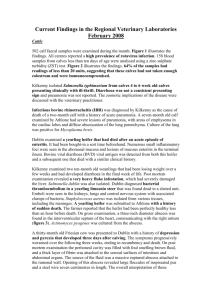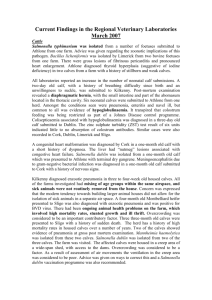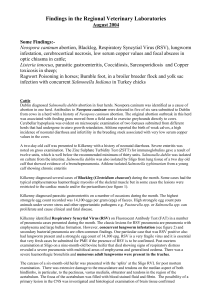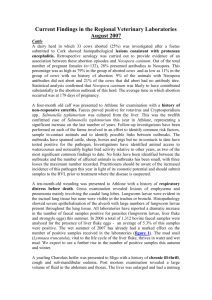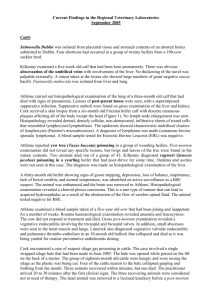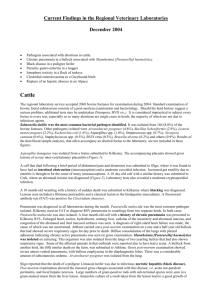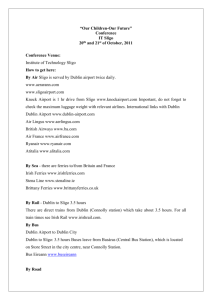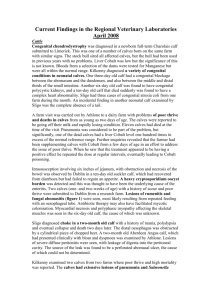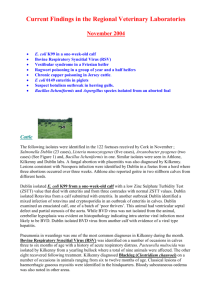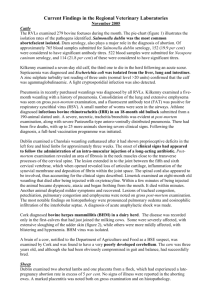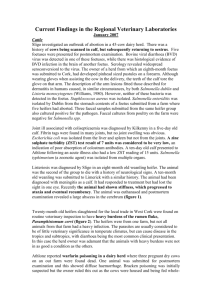March 2008
advertisement
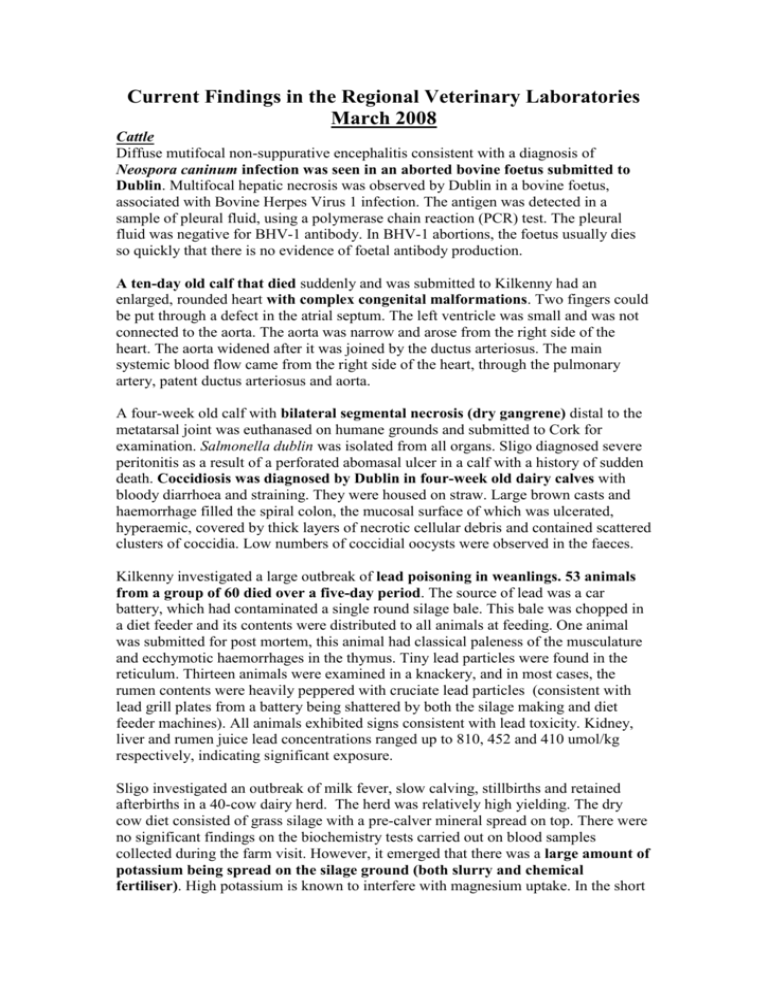
Current Findings in the Regional Veterinary Laboratories March 2008 Cattle Diffuse mutifocal non-suppurative encephalitis consistent with a diagnosis of Neospora caninum infection was seen in an aborted bovine foetus submitted to Dublin. Multifocal hepatic necrosis was observed by Dublin in a bovine foetus, associated with Bovine Herpes Virus 1 infection. The antigen was detected in a sample of pleural fluid, using a polymerase chain reaction (PCR) test. The pleural fluid was negative for BHV-1 antibody. In BHV-1 abortions, the foetus usually dies so quickly that there is no evidence of foetal antibody production. A ten-day old calf that died suddenly and was submitted to Kilkenny had an enlarged, rounded heart with complex congenital malformations. Two fingers could be put through a defect in the atrial septum. The left ventricle was small and was not connected to the aorta. The aorta was narrow and arose from the right side of the heart. The aorta widened after it was joined by the ductus arteriosus. The main systemic blood flow came from the right side of the heart, through the pulmonary artery, patent ductus arteriosus and aorta. A four-week old calf with bilateral segmental necrosis (dry gangrene) distal to the metatarsal joint was euthanased on humane grounds and submitted to Cork for examination. Salmonella dublin was isolated from all organs. Sligo diagnosed severe peritonitis as a result of a perforated abomasal ulcer in a calf with a history of sudden death. Coccidiosis was diagnosed by Dublin in four-week old dairy calves with bloody diarrhoea and straining. They were housed on straw. Large brown casts and haemorrhage filled the spiral colon, the mucosal surface of which was ulcerated, hyperaemic, covered by thick layers of necrotic cellular debris and contained scattered clusters of coccidia. Low numbers of coccidial oocysts were observed in the faeces. Kilkenny investigated a large outbreak of lead poisoning in weanlings. 53 animals from a group of 60 died over a five-day period. The source of lead was a car battery, which had contaminated a single round silage bale. This bale was chopped in a diet feeder and its contents were distributed to all animals at feeding. One animal was submitted for post mortem, this animal had classical paleness of the musculature and ecchymotic haemorrhages in the thymus. Tiny lead particles were found in the reticulum. Thirteen animals were examined in a knackery, and in most cases, the rumen contents were heavily peppered with cruciate lead particles (consistent with lead grill plates from a battery being shattered by both the silage making and diet feeder machines). All animals exhibited signs consistent with lead toxicity. Kidney, liver and rumen juice lead concentrations ranged up to 810, 452 and 410 umol/kg respectively, indicating significant exposure. Sligo investigated an outbreak of milk fever, slow calving, stillbirths and retained afterbirths in a 40-cow dairy herd. The herd was relatively high yielding. The dry cow diet consisted of grass silage with a pre-calver mineral spread on top. There were no significant findings on the biochemistry tests carried out on blood samples collected during the farm visit. However, it emerged that there was a large amount of potassium being spread on the silage ground (both slurry and chemical fertiliser). High potassium is known to interfere with magnesium uptake. In the short term the farmer was advised to dose the cows with magnesium chloride as they approached calving. In the longer term, a reduction in potassium usage was recommended. An emaciated three-year old heifer with a history of chronic scour was submitted to Athlone for post mortem examination. The jejunum and ileum had a corrugated appearance, with mucoid exudate on the mucosal surface (figure 1). The mesenteric lymph nodes were not enlarged. A dark viscous scour was evident in the large intestine. Histopathology revealed a granulomatous enetritis present with giant cells in both the mesenteric lymph nodes and the peyers patches. Culture for Mycobacterium avium subspecies paratuberculosis was positive. Sligo reported that Salmonella typhimurium was isolated from six faecal samples submitted from a dairy herd. This herd had an epidemic of scour and milk drop in adult cows. A member of the farm family was also severely affected with vomiting and diarrhoea. The farm is situated in close proximity to a licensed landfill site and to an abattoir. Investigations into the source of the infection and into the serotype of the isolate are continuing. Sligo diagnosed necrotising tracheitis with secondary bacterial pneumonia (Arcanobacter pyogenes isolated) as the cause of death of a feedlot cow. One other cow had already died and the other cows in the pen were showing clinical disease. Infectious bovine rhinotracheitis (IBR) virus was identified using a PCR test. Sheep Four lambs were submitted to Dublin from a farm experiencing poor, weak lambs at birth. The perinatal mortality rate was significantly higher than expected. Imperforate urethra with secondary hydronephrosis (figure 2) was diagnosed in one animal; another had severe abomasal distension and multifocal abscessation in the liver and spleen, indicative of gram-negative septicaemia. The remaining two lambs had low zinc sulphate turbidity (ZST) test results indicating inadequate absorbtion of colostrums antibodies; one of these had evidence of aspiration pneumonia while the other had an empty abomasum and depleted fat reserves. Three of the lambs also had low liver cobalt levels (0.24, 0.49 and 0.65 mol/kg, normal range 0.7 – 5.0). Cobalt deficiency in ewes has been associated with reduction in the viability of offspring. Three lambs were submitted to Athlone with a history of severe arthritis. Streptococcus dysgalactiae was isolated from the joints. ZST test results were normal. Kilkenny isolated Streptococcus agalactiae from the liver, lung and heart valve of a five-week old lamb with gross lesions of endocarditis involving the right atrioventricular valve. Athlone examined a two-week old lamb, which was found dead. Pinpoint abscesses were seen on the surface of the liver and Listeria monocytogenes was isolated from multiple organs. Three adult sheep were submitted to Cork from a flock where 32 out of 70 had died after showing symptoms of weakness and haemoglobinuria. Gross lesions consistent with chronic copper toxicosis were observed (icterus, gun-metal colored kidneys, enlarged yellow friable liver) in all three. Liver copper concentrations were elevated in all three animals, with one as high as 12.76mmol/kg wet matter (normal range 0.06 to 2.5 mmol/kg). Selenium and Cobalt concentration were also elevated. Other Species Sligo reported that Salmonella typhimurium was isolated from a Greenfinch (Carduelis chloris) and a Siskin (Carduelis spinus) found dead at a bird feeder in an urban garden. The garden owner was advised on the need to clean and disinfect wild bird feeders regularly, to move the feeding area periodically, and to practice scrupulous personal hygiene after handling the feeders and before eating or drinking. Kilkenny examined a twenty-eight-year old donkey with a history of rapid weight loss, anorexia and azotaemia. A single spherical mass, about 1cm in diameter, was found in one kidney. This was diagnosed as a focal renal adenoma. There was also extensive chronic interstitial nephritis, which was considered to be the important lesion. CAPTIONS FOR PHOTOS Figure 1 “Corrugated appearance of the ileum associated with Johnes disease in a three-year old heifer – photo Gerard Murray” Figure 2 “Hydronephrosis in a lamb – photo Ann Sharpe”
